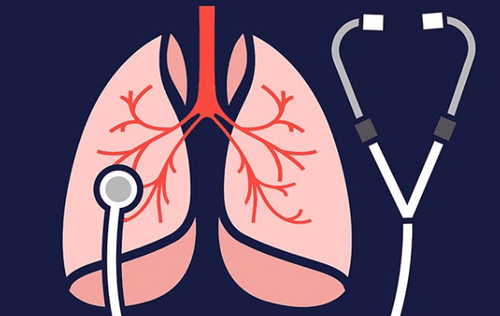This is an automatically translated article.
Chronic obstructive pulmonary disease (COPD) is a chronic inflammatory lung disease that causes blocked airflow from the lungs. COPD cannot be completely cured, but treatment can help most people with the disease control symptoms and have a good quality of life, as well as reduce the risk of other related diseases.
1. What is chronic obstructive pulmonary disease?
Chronic obstructive pulmonary disease, commonly known as COPD (Chronic obstructive pulmonary disease) is a group of progressive lung diseases. The most common are emphysema, chronic bronchitis, or both. Emphysema slowly destroys the air sacs in your lungs, obstructing the flow of air to the outside. Bronchitis causes inflammation and narrowing of the bronchial tubes, causing a buildup of mucus.
The leading cause of chronic obstructive pulmonary disease is smoking. Long-term exposure to chemical irritants can also lead to COPD. Chronic obstructive pulmonary disease is a disease that often takes a long time to develop. Diagnosis usually includes imaging tests, blood tests, and lung function tests.

Chẩn đoán COPD bằng hình ảnh
Trắc nghiệm: Làm thế nào để có một lá phổi khỏe mạnh?
Để nhận biết phổi của bạn có thật sự khỏe mạnh hay không và làm cách nào để có một lá phổi khỏe mạnh, bạn có thể thực hiện bài trắc nghiệm sau đây.2. How to know if you have chronic obstructive pulmonary disease?
Chronic obstructive pulmonary disease symptoms often do not appear until significant lung damage has occurred, and they often worsen over time, especially if the patient continues to smoke. COPD makes it hard to breathe. Initial symptoms can be mild, starting with a persistent cough and shortness of breath. You may have wheezing and tightness in your chest or have a lot of phlegm.Some people with chronic obstructive pulmonary disease have exacerbations, which are outbreaks of severe symptoms. At first, the symptoms of chronic obstructive pulmonary disease can be quite mild. You might mistake it for the common cold. Early symptoms include:
Occasional shortness of breath, especially after physical activity Mild but recurrent cough Must clear throat every morning, due to excess mucus in lungs Symptoms can can become progressively worse and harder to ignore. As the lungs become more damaged, you may experience:
Shortness of breath, after light exercise like walking up stairs Wheezing, especially during exhalation Chest tightness Chronic cough, with or without substance mucus Need to clear mucus from your lungs every day Frequent colds, flu or other respiratory infections Lack of energy

Khi phổi bị tổn thương nhiều sẽ gây ra triệu chứng ho mãn tính
Fatigue Swelling of the feet, ankles or legs Weight loss You need immediate medical attention if these signs appear. The following are signs:
Notice how blue or gray your fingernails or lips are, as this indicates low blood oxygen levels Feeling short of breath or unable to talk Feeling confused, confused, or fainting Heart pounding Symptoms is likely to be much worse if you currently smoke or are regularly exposed to secondhand smoke.
3. Is chronic obstructive pulmonary disease curable?
Currently, chronic obstructive pulmonary disease has not been completely cured, but being diagnosed with COPD is not the end of all hope. Because most people have mild forms of the disease that require little treatment other than smoking cessation. Even for more advanced stages of the disease, effective therapy is available that can control symptoms, reduce the risk of serious complications, and improve quality of life.The most essential step in any chronic obstructive pulmonary disease treatment plan is to stop smoking. It's the only way to keep COPD from getting worse. But quitting smoking isn't easy, and it can seem daunting if you've tried to quit and failed. Talk to your doctor about nicotine replacement products and smoking cessation aids, as well as how to handle relapses.

Cố gắng ngừng hút thuốc để COPD không phát triển nặng hơn
Medical treatment: Bronchodilators are drugs that relax the muscles of the airways, widening the airways so you can breathe more easily. Glucocorticosteroids may be added by your doctor to reduce inflammation in the airways. To reduce your risk of other respiratory infections, ask your doctor if you'd like your annual flu shot, pneumococcal, and pertussis vaccine. Oxygen therapy: If your blood oxygen level is too low, you may be prescribed to receive supplemental oxygen through a mask or a nasal cannula to help you breathe better. Surgery is indicated for severe chronic obstructive pulmonary disease or when other treatments have failed, more likely when you have a severe form of emphysema.
Unlike some diseases, chronic obstructive pulmonary disease has a clear cause and is completely preventable. The majority of cases are directly related to smoking, and the best way to prevent COPD is to never smoke - or to stop smoking now. Occupational exposure to chemical fumes and dust is another risk factor for COPD. If you work with this type of lung toxicant, talk to your supervisor about the best ways to protect yourself, such as using respiratory protection.
Vinmec International General Hospital is one of the hospitals that not only ensures professional quality with a team of leading medical doctors, modern equipment and technology, but also stands out for its examination and consultation services. comprehensive and professional medical consultation and treatment; civilized, polite, safe and sterile medical examination and treatment space.
Customers can directly go to Vinmec Health system nationwide to visit or contact the hotline here for support.
Articles refer to sources: healthline.com, mayoclinic.org













